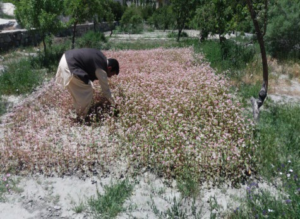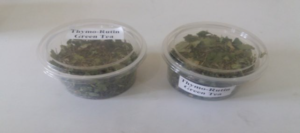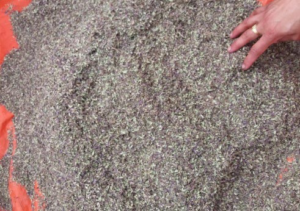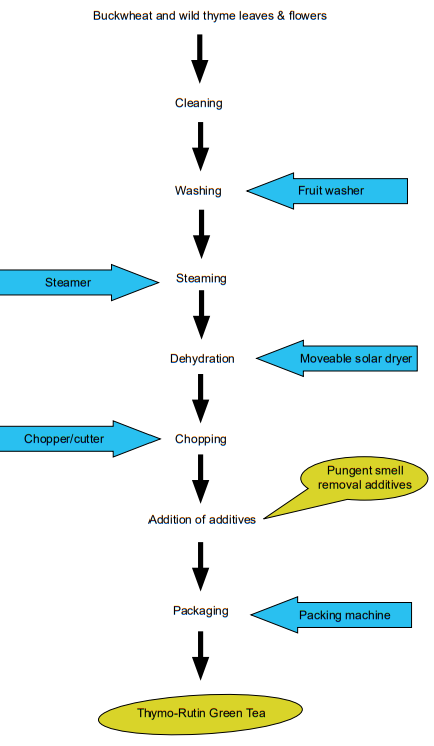INTRODUCTION
The Thymo-Rutin Green Tea has been developed by the utilization off buckwheat and thymus leaves flowers from the stand point of its nutritional importance. The Thymo-Rutin Green Tea can be used by common people especially for mountain expediters, soldier performing their duties in high altitudes i.e., siachen glacier, kargil, and other common peoples of high altitudes who feels headache due to deficiency of Oxygen, players of football, hockey and athletes who have chances to rupture capillary walls. The product also provides appreciable amount of different nutrients like caffeine, thymol and rutin.
Wild Thyme
Wild thyme belongs to genus Thymus known as thyme, it has 215 species that has commercial importance.
In Pakistan (Gilgit-Baltistan), the genus is represented by the species Thymus serpyllum wild thyme. Thyme is most widely used culinary herbs. The dried leaves and flowers are used for food flavoring and the source of essential oil (EO) in pharmaceutical and food industries. A number of benefits in human and animal wellbeing have been associated with the use of thyme EO by the industry.3 At this point, this plant can be considered as a potential impulse of new trends in food, pharmaceutical and cosmetic industries.4 The thyme essential oil antioxidant potential has shown the uses of this product in food industry and effectiveness of oil demands for development of dietetic supplement.5 Recent studies have showed that thyme have strong antibacterial, antifungal, antiviral, antiparasitic and antioxidant activities.6,7,8,9,10
The antiseptic, antioxidative, insecticidal, preservative, and anesthetic properties of thyme EO are owed mainly to the presence of thymol, carvacrol, geraniol and other volatile components.11 Thymol helps in blood vessel treatment and purification of blood that helps in the easy dissolution of more oxygen in blood that is an important remedy for high altitudes like siachen glacier and other hits where there problems of deficiency of oxygen cause headache and other problems.
The chemical polymorphism of thyme has been reviewed by Stahl-Biskup. The most important component found in this genus is thymol and carvacol followed by linalool, pcymene, α-terpinene, borneol, terpinene-4-ol and 1, 8-cineole.12 In Pakistan the composition of this genus and detailed research work has not been undertaken so far.
The chemical composition of aromatic plants is significantly influenced by the plant part, season and plant ontogeny14,15,16 location of growing17 and drying.18,19
Buckwheat
Buckwheat (Fagopyrum esculentum) belongs to family Polygonaceae considered as pseudo cereals and used like wheat. Buckwheat is native to temperate East Asia and was grown in China before 1000 AD; it is now adapted in many areas of the world. Although buckwheat production is concentrated in China, Japan and North America, it is also produced in Europe, India, Tibet, Tasmania, Australia, Argentina, Bhutan and numerous other countries. The name “buckwheat” comes from the Anglo-Saxon words boc (beech) and whoet (wheat) because the seed resembles a small beech nut. The presence of rutin in buckwheat plants is one of the main reasons for the production of different kinds of buckwheat foods. Buckwheat is a very short season crop so that it will bloom in cooler weather i.e. high altitude or alpine zone as crop seeds, flowers and leaves are used as health food. Buckwheat occupies 948 hectares during 2014 in Gilgit Baltistan of Pakistan. The leaves and flowers of buck wheat contain rutin content that strengthens capillary walls. Food produced from buckwheat is gluten free and good source of nutrients including protein starch and essential minerals thus buckwheat have beneficial effect on human health,20,21,22 increasing attention to buckwheat as a functional food has been currently paid,23,24 there are two cultivated species common buckwheat (sweet) and tartary buckwheat sweet buckwheat is commonly used.
Globally the major deaths caused by cardiovascular disease. Although, typically considered a disease of developed countries, its incidence is increasing in the developing world. There may be more than 20 million people will die with cardiovascular disease per year mainly due to heart attacks and strokes up to 2025, if immediate action is not taken.25
In recent times, especially in all industrially developed countries, consumers are becoming more interested in foods which offer an added value in terms of health benefits. Functional foods have disease preventing and health promoting properties along with its basic nutritional functions, these foods may be processed or fresh. The term was first used in Japan in the 1980s, where there is a government approval process for functional foods, called Foods for Specified Health Use (FOSHU).26 The consumption of functional foods with an increased content of rutin may be a way of reducing the risk of cardiovascular diseases in the population.
Rutin
Rutin is responsible for blood vessel elasticity, strengthening of capillary walls, circulatory disorder treatment due to its therapeutic ability. It belongs to bioflavonoids group of phenolic metabolites. It has antioxidant activity, reduce blood pressure and utilize vitamin C.27,28,29,30
Rutin abundantly found in plants, that is flavonoid glycoside, but unfortunately industrial extraction is possible from only a small number of plants31 Schunck in 19th century first discovered rutin content in buckwheat; he isolated only 240 gram from 30 pounds fresh buckwheat leaves.32
Rutin in Buckwheat
Approximately 50 years ago, buckwheat was cultivated as a rich source of rutin for herbal drug production in the USA. At present, buckwheat rutin is the well-known dietary source until know. Common Buckwheat (pseudocereal) (Fagopyrum esculentum Moench) belonging to family polgonaceae is a dicotyledonous plant (and Tartary buckwheat (Fagopyrum tataricum Gaertn) is the only two of the many buckwheat species known that are cultivated for human consumption. Buckwheat is a natural functional food, because it positively affects the human organism biologically (for example low glycemic index and reduced capillary fragility) without the necessity of adding any other components. Buckwheat is uniquely rich in proteins (12-15%) and essential amino acids, such as lysine (5-7%), that are deficient in major cereal crops, but also contains an abundance of lipids, fibers, minerals (zinc, manganese, selenium, iron, phosphorus, and copper), and vitamins (B1 and B2).33,34,35,36,37,38
Buckwheat Usage
The leaves and flowers are used to develop green tea due to its rutin content. The dehulled seed, or groat, is used in breakfast cereals and milled into grits. Buckwheat gluten free flour can be used as noodles, pancake mix, biscuits, etc. buckwheat gluten free flour also blended with wheat flour for development of bread, and other breakfast product prepration. roasted groats, may be steamed, roasted, boiled. In Eastern Europe, buckwheat flour is used in cooking similar to wheat flour. Bread, cakes and dumplings are made with the addition of wheat flour. Buckwheat gluten free flour also blended 30-40% for development of baby foods. Buckwheat flour also use in manufacturing of ice-cream, dietetic foods, canned meat products. Pasta produced from a mixture of wheat and buckwheat flour has been characterized to possess shorter cooking time. Extruded and snack products can also be developed from buckwheat flour. Extruded buckwheat products are of very high nutritional quality when compared with products extruded from wheat.39Buckwheat extruded products developed for special nutritional needs due to it specific protein character. As buckwheat does not contain gluten, it is a common supplement for patients with celiac disease. Buckwheat intolerance is rare among patients with gluten intolerance alone, but more common in those with celiac disease combined with other food allergies. Allergic reactions are caused by ingestion of allergenic buckwheat proteins.40 Other products made from buckwheat are green buckwheat tea, buckwheat beer and vinegar, spirit, buckwheat floral honey, buckwheat sprouts and fresh green plant parts used as a vegetable. Rutin content in buckwheat depends on species, harvest conditions, and the environmental conditions under which it is produced.41,42
Easily dehulled and large size of seeds and sweet taste of common buckwheat increased its consumption.
Rutin and other components are higher in Tartary buckwheat as compared to common or sweet buckwheat so the demand of Tartary buckwheat use is also increased in food companies. Consumption of tartary buckwheat is very less because the dehulling of tartary buckwheat is very difficult due to firm adherences of testa, seed small in size and bitter taste.
Different parts of buckwheat has different amount of rutin content i.e. flour, leaves, flower and stem.
The highest content of rutin can be found in buckwheat leaves, but buckwheat tops are much easier to use as a source of Rutin, considering the costs connected with the harvesting technology. Rutin content is higher in dry leaves, flowers as compared to flour and stem.
MATERIALS AND METHODS
The process of preparation for thymo-rutin green tea involves collection of leaves and flowers, washing, cleaning, steaming, dehydration, addition of additives, cutting and packaging.
Green Tea Preparation Method
Leaves and flowers of buckwheat (Fagopyrum esculentum) and wild thyme (Thymus serpyllum) were collected for the development of thymo-rutin green tea. The thyme leaves collected from devosi plane (dehydrated thyme leaves and flowers also available in Skardu market) and buckwheat cultivated in Pakistan Council of Scientific and Industrial Research (PCSIR) orchard the leaves and flowers were collected after flowering before seed formation. The harvested leaves and flowers washed to remove dust and cleaned for removal of weeds and other particles. The cleaned, washed leaves and flowers passed through steam to fix green colour and sterilization. The cleaned and washed leaves, flowers of buckwheat and wild thyme dehydrated in solar dehydrator. The dehydrated leaves and flowers chopped with chopper up to desired size. Wild thyme removed the pungent smell of buckwheat leaves and flowers. The developed thymo-rutin green tea packed in polyethylene zip bags and packets (Figures 1 and 2).
Figure 1: Pictorial View of Buckwheat Crop, Dehydrated wild Thyme Leaves and Developed Product Thymo-Rutin Green Tea.



Figure 2: Flow Diagram Thymo-Rutin Green Tea.

Sensory/Organoleptic Evaluation of Thymo-Rutin Green Tea
The organoleptic/sensory evaluation for taste, color, flavour, mouth feel and overall acceptability conducted using nine point hedonic scale in accordance with the method described by Larmond.43 The panel members were selected on the basis of their ability to discriminate and scale abroad range of different attributes of Green tea. An orientation program was organized for the panel members to brief them the objective of the study. The sample was served members of organoleptic/sensory analysis. The members were advised to record their observation as per questionnaires. Larmond nine point hedonic scale used to develop Performa i.e. 1=Disliked extremely; 2=Disliked very much; 3=Disliked moderately; 4=Disliked slightly; 5=Neither liked nor disliked; 6=Liked slightly; 7=Liked moderately; 8=Liked very much; 9=Liked extremely; The members of sensory evaluation expectorated the samples and rinsed mouth using distilled water between samples. The experiment was repeated twice and the values are presented as means.
Chemical Analysis
The thymo-rutin green tea (final product) prepared were chemically analyzed for their moisture, total ash, Extracting value (ethanol), rutin, caffeine and thymol by standard method (AOAC2000) respectively. Moisture was determined by oven drying at 105 ºC, up to constant weight.
Rutin: The analysis of rutin content in dry leaves and flowers were performed according to the Association of Official Agricultural Chemists (AOAC) official method.44 This method has been modified using high-performance liquid chromatography (HPLC) 80% methanol. 0.5 g of the sample is dissolved into 50 ml HPLC 80% methanol. Then 2 ml of the extract thus obtained is transferred into 50 ml volumetric flask. Two ml dabble distilled water and 5 ml ammonium molybdate are added. Then the mixture is diluted to 50 ml. The standard solution is prepared through dissolving of 0.02 g rutin in 50 ml HPLC 80% methanol. Then 1 ml of this solution is used. The absorbance of the sample against dabble distilled water as a blank sample was determined at 360 nm with an ultraviolet and visible (UV-Vis) Spectrophotometer. Samples were analyzed in duplicate. Thymol extraction was carried out in a solvent extraction unit and determination of thymol was conducted by gas chromatograph (GC) mass spectrometer. Ash count was determined in a muffle furnace at 550 ºC for 6 hours. For all these determinations dry green tea samples used in duplicate in accordance with standard procedures.45
RESULTS AND DISCUSSION
For the development of thymo-rutin green tea an optimal recipe was explored and required ingredients was considered carefully. Some food grade additives were selected for the study. The ingredients were selected after conducting exploratory and subsidiary trails. Physical trails were employed during above trails using a 9-point hedonic scale.
The sensory evaluation of the product was carried out to check its color, taste, flavour, mouth feel and overall acceptability as shown in Table 1. On the basis of sensory evaluation of the developed product the thymo-rutin green tea was found acceptable. The organoleptic result of the product shows that the mix product of thyme and buckwheat gives better results in term of taste, colour, flavour, mouth feel and over all acceptability. The final product was further analyzed for rutin, thymol, and caffeine contents to check its suitability for nutritional purpose.
| Table 1: Sensory/Organoleptic Evaluation of Thymo-Rutin Green Tea. |
|
Parameter
|
Panel member 1 |
Panel member 2 |
Panel member 3 |
| Color |
8 |
8.4 |
8.5
|
|
Taste
|
9 |
8 |
8.5 |
| Flavour |
8 |
8.5 |
8.7
|
|
Mouth feel
|
8.3 |
8.8 |
8 |
| Overall acceptability |
8 |
8.5 |
8.6
|
Table 2 depicts the ratio tried for acceptable buckwheat leaves, flowers and thyme leaves, flowers. Optimum ratio was found to be 4:1 of buckwheat and thyme. The leaves and flowers after cleaning and washing passed through steam and dehydrated in solar dryer and immediately packed in polyethylene bags for maximum availability of thymol and rutin.
| Table 2: Ratios of ingredients Tried for Acceptable Green Tea Production. |
|
Ingredients
|
Level used
|
Optimum level
|
|
1
|
2 |
3 |
4 |
5 |
6 |
7
|
|
Buckwheat
|
1 |
2 |
3 |
4 |
5 |
4 |
3 |
4 |
| Thyme |
4 |
3 |
3 |
3 |
0 |
1 |
2
|
1
|
Table 3 depicts the nutritional composition of the developed green tea. The moisture, ash, caffeine, ethanol, rutin and thymol contents observed were moisture 5.01%, total ash 11.91%, caffeine 0.35%, ethanol 18.93%, rutin content 1.99% and thymol content was observed 0.21%. The data showed that the developed product is a good source of thymol, rutin and caffeine. Thymol (2-isopropyl-5-methylphenol) is the main compounds have shown anti-inflammatory, immunomodulatory, antioxidant, antibacterial and antifungal properties.43,44 Rutin is one of the flavonoid, flavonoids belongs to the plant phenolics.
| Table 3: Chemical Analysis of Thymo-Rutin Green Tea. |
|
S.No
|
Parameters |
Thymo-Rutin Green Tea %
|
|
1
|
Moisture |
5.01±0.26 |
| 2 |
Ash |
11.91±0.09
|
|
3
|
Caffeine |
0.35±0.09 |
| 4 |
Extractive value (ethanol) |
18.93±0.17
|
|
5
|
Rutin |
1.99±0.07 |
| 6 |
Thymol |
0.21±0.02
|
| Values are mean of duplicate determinations±SD |
The importance of rutin content due to its strong biological activity attracts researchers for its evaluation in different parts of buckwheat i.e., leaves flowers and flour, etc. The highest content of rutin was found in the developed green tea. The developed product is a mixed product of wild thyme leaves and buckwheat leaves and flowers.
Nutritional data of product also shows that it is an important therapeutic product that contains ethanol and caffeine active ingredient with rutin and thymol that is helpful for reduction of cardiovascular disease, blood vessel elasticity, treatment of circulatory disorders, blood vessel treatment, purification of blood, increase oxygen dissolubility, atherosclerosis, reduction of blood pressure, stimulates of Vitamin C utilization and antioxidant activity.
CONCLUSION
It is concluded from the study that the developed product green tea is acceptable in buckwheat and thyme leaves and flowers combination. The develop product is a good source of rutin, thymol and caffeine which are beneficial to health and wellbeing of all individuals. The rutin and thymol makes the green tea an essential nutritional supplement especially for athletes, soldiers, mountain climbers and common peoples of above 8000 feet altitude. Rutin strengthen capillary walls, increase elasticity of veins, and thymol blood vessel treatment and increase dissolubility of more oxygen (O2 ). The product green tea can be used by all age group.
CONFLICTS OF INTEREST
The authors have not declared any conflicts of interest.









